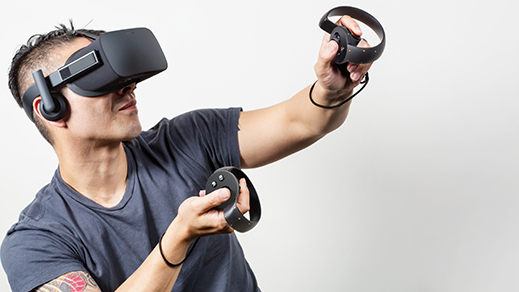Oculus Shows Its First Consumer Headset, Circular Hand Controls
Oculus’s first consumer virtual-reality headset, the Oculus Rift, won’t be released until next year and a price has not yet been revealed, but it got a little closer to reality today as the company officially unveiled it along with a unique pair of circular controllers.

Oculus CEO Brendan Iribe held up the headset during a media event in San Francisco meant to preview what Oculus will exhibit at the E3 video-game convention in Los Angeles next week: a matte black device that slips over the head like a baseball cap, looking like a slightly sleeker version of the developer headsets the company had previously demonstrated.
Oculus Rift is perhaps the most anticipated of the coming virtual-reality headsets. The company, which was purchased by Facebook for $2 billion in 2014, plans to release it during the first quarter of next year.
The headset has two OLED screens, a wide field of view, a small dial to adjust the distance between your pupils, and a new tracking system to determine your position, Iribe said. A black sensor that looks like a microphone plugs into a computer (a computer will be required for the Rift to work, as the headset must physically connect to it), and there will be removable speakers over each ear.
“It’s really lightweight, it’s comfortable,” Iribe said. “You can slip it right on.” Oculus founder Palmer Luckey also showed prototypes today of hand controls called Oculus Touch that the company hopes will make it easy to use your hands in virtual reality, whether you want to pick up and fire a gun or give a friend a virtual thumbs up. The gadget looks like a tiny game controller for each hand, complete with buttons and a trigger, surrounded by a black semicircle. It will be released in the first half of next year.
Luckey said the controllers are meant to allow precise, quick control of virtual objects without requiring the user to really think much about it. With the controllers, users can also make hand gestures like pointing, waving, and giving a thumbs up, he said, and developers can add haptic buzzes to games that you’ll feel with the controllers.
Steve Janiak, CEO of Cambridge, Massachusetts-based Harmonix, which makes games including Rock Band and is working on a music game for the Rift, has tried out the controllers and says they’re the best he’s used so far for virtual-reality gaming.
“You almost don’t even feel like you have them in your hands; it’s just an extension of your virtual self,” he said.
In addition to the small handheld controllers, Oculus is partnering with Microsoft to include a wireless Xbox controller with the Rift headset, and the Rift will work natively with Windows 10. The Rift will also work with games made for Xbox; Oculus created a virtual cinema where the games will be available.
While a number of gaming companies—including Gunfire Games and CCP Games, who were on hand today—are already making games for the Rift, the work with Microsoft will make many more games available for the platform right off the bat, and could entice more game developers to build games expressly for Oculus.
Keep Reading
Most Popular
Large language models can do jaw-dropping things. But nobody knows exactly why.
And that's a problem. Figuring it out is one of the biggest scientific puzzles of our time and a crucial step towards controlling more powerful future models.
The problem with plug-in hybrids? Their drivers.
Plug-in hybrids are often sold as a transition to EVs, but new data from Europe shows we’re still underestimating the emissions they produce.
Google DeepMind’s new generative model makes Super Mario–like games from scratch
Genie learns how to control games by watching hours and hours of video. It could help train next-gen robots too.
How scientists traced a mysterious covid case back to six toilets
When wastewater surveillance turns into a hunt for a single infected individual, the ethics get tricky.
Stay connected
Get the latest updates from
MIT Technology Review
Discover special offers, top stories, upcoming events, and more.